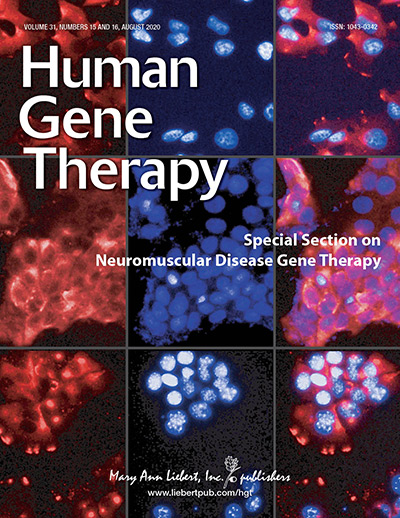For Immediate Release
Toxicity of Dorsal Root Ganglia Is Widely Associated with CNS AAV Gene Therapy
Contact: Kathryn Ryan
914-740-2250
kryan@liebertpub.com

New Rochelle, NY, September 2, 2020—A meta-analysis of non-human primate (NHP) studies showed that adeno-associated virus (AAV) gene therapy often caused dorsal root ganglion (DRG) pathology. There were no clinical effects. The study is reported in the peer-reviewed journal Human Gene Therapy. Click here to read the full-text article free on the Human Gene Therapy website through October 2, 2020.
The dorsal root ganglion is a cluster of neurons in the dorsal root of a spinal nerve. DRG pathology was present in 83% of NHP given AAV through the cerebrospinal fluid and 32% of NHP that received an intravenous injection.
The data suggest that “DRG pathology is almost universal after AAV vectors are delivered into the cerebral spinal fluid of nonhuman primates. However, none of the animals receiving a vector expressing a therapeutic transgene displayed any clinical signs,” stated James M. Wilson, MD, PhD, a professor of Medicine and director of the Gene Therapy Program and the Orphan Disease Center, and coauthors from the Perelman School of Medicine at the University of Pennsylvania.
“The DRG pathology associated with AAV has triggered an increase in the intensity of preclinical evaluation of AAV vectors prior to initiation of clinical trials of new vectors,” according to Editor-in-Chief of Human Gene Therapy Terence R. Flotte, MD, Celia and Isaac Haidak Professor of Medical Education and Dean, Provost, and Executive Deputy Chancellor, University of Massachusetts Medical School. “The insights offered by Dr. Wilson’s paper provide an excellent summary perspective on this phenomenon, which could potentially eliminate the need for a number of redundant preclinical safety studies and thus shorten the path to the clinic for new vectors.”
Individual studies utilized for data extraction were supported by REGENXBIO (all studies previously published), Biogen (some studies previously published), Passage Bio, Amicus Therapeutics, ODC MPS I pilot grant MPS-18-D010-01 and MPS-19-001-0, Janssen, Cure FA, Rett Syndrome Research Trust and Elaaj Bio. These entities funded the original studies whose samples were later run through the comparative meta-analysis covered in the manuscript. The studies, company sponsor, and transgenes representing each data point are not disclosed.
About the Journal
Human Gene Therapy ,the Official Journal of the European Society of Gene and Cell Therapy and eight other international gene therapy societies, was the first peer-reviewed journal in the field and provides all-inclusive access to the critical pillars of human gene therapy: research, methods, and clinical applications. The Journal is led by Editor-in-Chief Terence R. Flotte, MD, Celia and Isaac Haidak Professor of Medical Education and Dean, Provost, and Executive Deputy Chancellor, University of Massachusetts Medical School, and an esteemed international editorial board. Human Gene Therapy is available in print and online. Complete tables of contents and a sample issue are available on the Human Gene Therapy website.
About the Publisher
Mary Ann Liebert, Inc., publishers is known for establishing authoritative peer-reviewed journals in many promising areas of science and biomedical research. Its biotechnology trade magazine, GEN (Genetic Engineering & Biotechnology News), was the first in its field and is today the industry’s most widely read publication worldwide. A complete list of the firm’s 90 journals, books, and newsmagazines is available on the Mary Ann Liebert, Inc., publishers website.